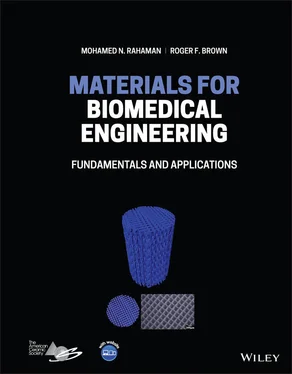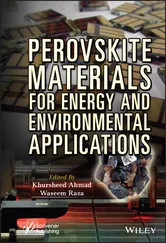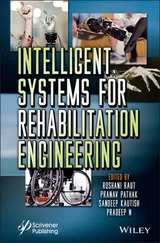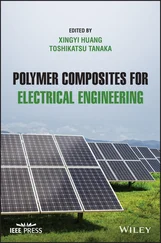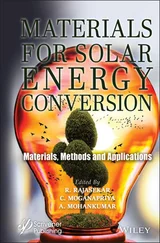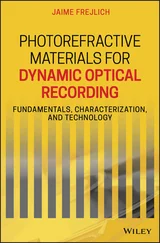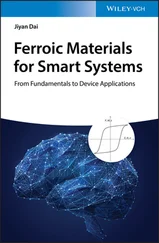Mohamed N. Rahaman - Materials for Biomedical Engineering
Здесь есть возможность читать онлайн «Mohamed N. Rahaman - Materials for Biomedical Engineering» — ознакомительный отрывок электронной книги совершенно бесплатно, а после прочтения отрывка купить полную версию. В некоторых случаях можно слушать аудио, скачать через торрент в формате fb2 и присутствует краткое содержание. Жанр: unrecognised, на английском языке. Описание произведения, (предисловие) а так же отзывы посетителей доступны на портале библиотеки ЛибКат.
- Название:Materials for Biomedical Engineering
- Автор:
- Жанр:
- Год:неизвестен
- ISBN:нет данных
- Рейтинг книги:4 / 5. Голосов: 1
-
Избранное:Добавить в избранное
- Отзывы:
-
Ваша оценка:
- 80
- 1
- 2
- 3
- 4
- 5
Materials for Biomedical Engineering: краткое содержание, описание и аннотация
Предлагаем к чтению аннотацию, описание, краткое содержание или предисловие (зависит от того, что написал сам автор книги «Materials for Biomedical Engineering»). Если вы не нашли необходимую информацию о книге — напишите в комментариях, мы постараемся отыскать её.
A comprehensive yet accessible introductory textbook designed for one-semester courses in biomaterials Materials for Biomedical Engineering: Fundamentals and Applications
Materials for Biomedical Engineering: Fundamentals and Applications
Materials for Biomedical Engineering — читать онлайн ознакомительный отрывок
Ниже представлен текст книги, разбитый по страницам. Система сохранения места последней прочитанной страницы, позволяет с удобством читать онлайн бесплатно книгу «Materials for Biomedical Engineering», без необходимости каждый раз заново искать на чём Вы остановились. Поставьте закладку, и сможете в любой момент перейти на страницу, на которой закончили чтение.
Интервал:
Закладка:
3 Chapter 3 Figure 3.1 Packing of atoms to give a simple cubic structure. (a) Single “sq... Figure 3.2 (a) Packing of “square” layers of atoms in ABAB pattern to give a... Figure 3.3 (a) Single “triangular” layer of atoms showing interstitial posit... Figure 3.4 (a) Packing of triangular layers of atoms in ABAB pattern to give... Figure 3.5 Geometry and parameters of a unit cell. Figure 3.6 The seven crystal systems and their parameters. Figure 3.7 The 14 Bravais lattices. Figure 3.8 Arrangement of sodium ions (Na +) and chlorine ions (Cl −) in... Figure 3.9 Illustration of (a) ordered arrangement of SiO 4tetrahedra in cry... Figure 3.10 (a) Arrangement of atoms in a phosphate (PO 4) 3−ion; (b) a... Figure 3.11 Schematic representation of the structure of a sodium silicate g... Figure 3.12 Tetrahedral arrangement of covalent bonded carbon atoms in diamo... Figure 3.13 (a) Basic building block of graphite composed of a planar array ... Figure 3.14 Arrangement of carbon atoms in (a) graphene, (b) single‐walled c... Figure 3.15 Schematic representation of (a) random arrangement of macromolec... Figure 3.16 Schematic representation of the types of point defects in a crys... Figure 3.17 Major substituting ions and approximated formula of hydroxyapati... Figure 3.18 Schematic representation of a dislocation in a crystal and the d... Figure 3.19 Schematic representation of part of a perfect crystal (a) and th... Figure 3.20 Schematic representation of the movement of an edge dislocation ... Figure 3.21 Schematic representation of slip in a metal that is subjected to... Figure 3.22 Illustration of (a) the boundary region between two grains and (... Figure 3.23 Examples of microstructures of dense biomaterials. (a) Al 2O 3sho... Figure 3.24 Examples of microstructures of porous biomaterials. (a) Bioactiv... Figure 3.25 Diagram illustrating the specification of lattice planes in a cr... Figure 3.26 Diagram illustrating the specification of lattice directions in ...
4 Chapter 4 Figure 4.1 Different loading modes in mechanical testing of materials: (a) t... Figure 4.2 Schematic stress–strain curve to illustrate the distinction betwe... Figure 4.3 Schematic diagrams to illustrate two types of plastic deformation... Figure 4.4 Linear viscoelastic behavior of polymers. (a) In creep, a constan... Figure 4.5 Two alternative versions of the Zener model, also called the stan... Figure 4.6 Schematic stress–strain curves to illustrate the characteristic r... Figure 4.7 Schematic stress–strain curves to illustrate the characteristic r... Figure 4.8 Local stress σ las a function of distance x from the tip ... Figure 4.9 Geometrical model used in the Griffith theory of brittle fracture... Figure 4.10 Area under the stress–strain curve used as measure of the relati... Figure 4.11 Schematic representation of the fracture surface of a ductile me... Figure 4.12 Geometry of hardness test using a Vickers indenter consisting of... Figure 4.13 Data for the Young’s modulus as a function of porosity for a tit... Figure 4.14 The influence of grain size on the yield strength of a 70Cu–30Zn... Figure 4.15 Weibull plots for porous bioactive glass (BG) specimens in compr... Figure 4.16 Bar chart showing the range of electrical conductivity for diffe... Figure 4.17 Simplified explanation of the electrical conductivity of conduct... Figure 4.18 Schematic diagram illustrating the two contributions to the magn... Figure 4.19 Schematic illustration of magnetic domains in a ferromagnetic ma... Figure 4.20 (a) Part of Fe 3O 4crystal structure showing the tetrahedral a si... Figure 4.21 Magnetization curve for a ferromagnetic or ferrimagnetic materia... Figure 4.22 (a) Vibration of a sphere connected by springs. (b) The atomic v... Figure 4.23 Chart showing the thermal conductivity values for a variety of m... Figure 4.24 Reflection, transmission, and absorption of a light beam inciden...
5 Chapter 5 Figure 5.1 Various types of surface characteristics: (a) rough or smooth; (b... Figure 5.2 Illustration of lower coordination and disrupted bonding of outer... Figure 5.3 Contributions to the Gibbs free energy change due to change in ar... Figure 5.4 Wetting behavior between a liquid and a solid showing (a) good we... Figure 5.5 Zisman plot for polymethyl methacrylate (PMMA) using various liqu... Figure 5.6 Homogeneous wetting (a) and heterogeneous wetting (b) of a rough ... Figure 5.7 Images showing contact angle of a deionized water drop on (a) mac... Figure 5.8 Illustration of the formation of an oxide surface layer on a clea... Figure 5.9 A model for reorientation of polymer surface functional groups du... Figure 5.10 Interaction of incident beam (electrons or X‐rays) with a solid,... Figure 5.11 XPS survey spectrum for an autoclaved titanium dental implant.... Figure 5.12 XPS high‐resolution spectrum of the Ti 2p peak for a machined ti... Figure 5.13 Production of surface charge on a hydroxylated metal oxide surfa... Figure 5.14 Production of negative or positive surface charge on surface com... Figure 5.15 Production of surface charge on a surface devoid of functional g... Figure 5.16 Illustration of the electrostatic charge distribution surroundin... Figure 5.17 Zeta potential as a function of pH, as measured by the streaming... Figure 5.18 Examples of surface topography accidentally introduced (a, b) or... Figure 5.19 Schematic illustrating surface roughness parameters that can hav... Figure 5.20 Emissions produced by the interaction of an electron beam with a... Figure 5.21 EDS spectrum of a borosilicate glass examined in the SEM, showin... Figure 5.22 Schematic illustrating (a) the main components of the AFM techni... Figure 5.23 Schematic curve of force versus separation between the tip and s... Figure 5.24 Schematic illustrating the principle of optical interferometry.... Figure 5.25 Topography of as‐fabricated silicon nitride obtained by (a) SEM,...
6 Chapter 6 Figure 6.1 Polymorphic transformation in iron, titanium, and cobalt. Figure 6.2 Free energy as a function of radius of nucleus. Δ G * is the free e... Figure 6.3 Activation energy q required for an atom to diffuse from A to B.... Figure 6.4 Illustration of the variation of the transformation rate with tem... Figure 6.5 (a) Diffusive transformation and (b) displacive transformation in... Figure 6.6 Time‐temperature‐transformation diagram for the FCC to BCC transf... Figure 6.7 Types of phases that can be present in a metal composed of two ph... Figure 6.8 The iron‐rich portion of the iron‐carbon phase diagram. Figure 6.9 Common production methods for metals: (a) forging, (b) rolling, (... Figure 6.10 Illustration of growth of dendritic grains during casting of a m... Figure 6.11 Obstruction of dislocation motion by precipitates. Dislocation c... Figure 6.12 Yield strength and elongation to failure (ductility) as a functi... Figure 6.13 Motion of a dislocation as it encounters a grain boundary. The b... Figure 6.14 Sketch illustrating how the microstructure of a metal is changed... Figure 6.15 Influence of alloying elements on the phase diagram of titanium ... Figure 6.16 Schematic phase diagram for Ti6Al4V that shows the martensite st... Figure 6.17 Images of Ti6Al4V microstructure produced under different therma... Figure 6.18 Portion of the cobalt–chromium phase diagram.Figure 6.19 Schematic illustration of the shape memory and superelastic effe...Figure 6.20 Illustration of stress versus strain response of superelastic an...Figure 6.21 Microstructure of porous tantalum formed by a CVD process.Figure 6.22 (a) Schematic of the surface modification of Zr alloy to produce...Figure 6.23 Optical images of Levai‐Laxzko stained sections of rat femurs im...
7 Chapter 7Figure 7.1 Types of materials in the overall field of ceramics.Figure 7.2 Microstructural flaws that may be present in ceramics.Figure 7.3 (a) Major processing steps in the production of ceramics by the s...Figure 7.4 High zirconia portion of the zirconia–yttria phase diagram. The s...Figure 7.5 Scanning electron microscope images showing typical microstructur...Figure 7.6 Illustration of transformation toughening mechanism in tetragonal...Figure 7.7 Illustration of crack deflection mechanism in silicon nitride (SiFigure 7.8 Solubility isotherms of various calcium phosphate compounds as a ...Figure 7.9 Variation of ionic concentrations in triprotic equilibrium for ph...Figure 7.10 Hydroxyapatite discs of varying porosity and pore size produced ...Figure 7.11 (a) Major steps in the setting (hardening) of calcium phosphate ...Figure 7.12 Comparison of typical calcium phosphate cement microstructure wi...Figure 7.13 Specific volume (volume per unit mass) as a function of temperat...Figure 7.14 Viscosity of three silicate glasses as a function of temperature...Figure 7.15 (a) Microspheres of Y 2O 3–Al 2O 3–SiO 2glass (25–40 μm) used in rad...Figure 7.16 Illustration of distinctive characteristics of bioactive glasses...Figure 7.17 (a) Optical micrograph of a 45S5 bioactive glass implant (BG) bo...Figure 7.18 Effect of composition on (a) reactivity of bioactive glasses as ...Figure 7.19 Effect of microstructure on the mechanical response of porous bi...Figure 7.20 Bioactive borate glass (13–93B3) composed of microfibers used in...Figure 7.21 Concentration of copper (Cu 2+) ions released from copper‐doped b...Figure 7.22 Illustration of the production of a glass‐ceramic by controlled ...Figure 7.23 Typical processing cycle for the production of glass‐ceramics.Figure 7.24 Illustration of relative nucleation and crystallization rates as...Figure 7.25 Formation of crystalline phases in lithium disilicate glass‐cera...Figure 7.26 Illustration of the mechanism of phase formation in lithium disi...Figure 7.27 SEM images showing the difference in microstructure between lith...
Читать дальшеИнтервал:
Закладка:
Похожие книги на «Materials for Biomedical Engineering»
Представляем Вашему вниманию похожие книги на «Materials for Biomedical Engineering» списком для выбора. Мы отобрали схожую по названию и смыслу литературу в надежде предоставить читателям больше вариантов отыскать новые, интересные, ещё непрочитанные произведения.
Обсуждение, отзывы о книге «Materials for Biomedical Engineering» и просто собственные мнения читателей. Оставьте ваши комментарии, напишите, что Вы думаете о произведении, его смысле или главных героях. Укажите что конкретно понравилось, а что нет, и почему Вы так считаете.
